Rainfall Trends and Malaria Occurrences in Limpopo Province, South Africa
Abstract
1. Introduction
2. Materials and Methods
2.1. Study Area
2.2. Datasets
2.3. Time Series Analysis
2.4. Trend Analysis
2.5. Inter-Annual Variation Analysis
2.6. Wavelet Coherence Analysis
3. Results
4. Discussion
5. Conclusions
Author Contributions
Funding
Acknowledgments
Conflicts of Interest
Ethical Statement
References
- Abdelrazig, S.; Ortori, C.A.; Davey, G.; Deressa, W.; Mulleta, D.; Barrett, D.A.; Fogarty, A.W. A metabolomic analytical approach permits identification of urinary biomarkers for Plasmodium falciparum infection: A case-control study. Malar. J. 2017, 16, 229. [Google Scholar] [CrossRef][Green Version]
- World Health Organization. World Malaria Report; World Health Organization: Geneva, Switzerland, 2018; ISBN 978-92-4-151171-1. [Google Scholar]
- Mharakurwa, S.; Mutambu, S.L.; Mberikunashe, J.; Thuma, P.E.; Moss, W.J.; Mason, P.R. Changes in the burden of malaria following scale up of malaria control interventions in Mutasa District, Zimbabwe. Malar. J. 2013, 12, 223. [Google Scholar] [CrossRef] [PubMed]
- Silal, S.P.; Barnes, K.I.; Kok, G.; Mabuza, A. Little F: Exploring the seasonality of reported treated malaria cases in Mpumalanga, South Africa. PLoS ONE 2013, 8, e76640. [Google Scholar] [CrossRef] [PubMed]
- Raman, J.; Morris, N.; Frean, J.; Brooke, B.; Blumberg, L.; Kruger, P.; Mabusa, A.; Raswiswi, E.; Shandukani, B.; Misani, E.; et al. Reviewing South Africa’s malaria elimination strategy (2012–2018): Progress, challenges and priorities. Malar. J. 2016, 15, 438. [Google Scholar] [CrossRef] [PubMed]
- Morris, N.; Frean, J.; Baker, L.; Ukpe, I.S.; Barnes, K.I.; Kruger, P.; Mabuza, A.; Raswiswi, E.; Maharaj, R.; Blumberg, L.; et al. Re-defining the extent of malaria transmission in South Africa: Implications for chemoprophylaxis. S. Afr. Med. J. 2013, 103, 861–874. [Google Scholar] [CrossRef] [PubMed]
- Adeola, A.M.; Botai, O.J.; Olwoch, J.M.; Rautenbach, C.D.W.; Adisa, O.M.; Taiwo, O.J.; Kalumba, A.M. Environmental factors and population at risk of malaria in Nkomazi municipality, South Africa. Trop. Med. Int. Health 2016, 21, 675–686. [Google Scholar] [CrossRef] [PubMed]
- Coetzee, M.; Kruger, P.; Hunt, R.H.; Durrheim, D.N.; Urbach, J.; Hansford, C.F. Malaria in South Africa: 110 years of learning to control the disease. S. Afr. Med. J. 2013, 103, 770–788. [Google Scholar] [CrossRef]
- Adeola, A.M.; Botai, J.O.; Rautenbach, H.; Adisa, O.M.; Ncongwane, K.P.; Botai, C.M.; Adebayo-Ojo, T.C. Climatic Variables and Malaria Morbidity in Mutale Local Municipality, South Africa: A 19-Year Data Analysis. Int. J. Environ. Res. Public Health 2017, 14, 1360. [Google Scholar] [CrossRef]
- Craig, M.H.; Kleinschmidt, I.; Nawn, J.B.; Le Sueur, D.; Sharp, B.L. Exploring 30 years of malaria case data in KwaZulu-Natal, South Africa: Part I. The impact of climatic factors. Trop. Med. Int. Health 2004, 12, 1247–1257. [Google Scholar] [CrossRef]
- Ranjbar, M.; Shoghli, A.; Kolifarhood, G.; Tabatabaei, S.M.; Amlashi, M.; Mohammadi, M. Predicting factors for malaria re-introduction: An applied model in an elimination setting to prevent malaria outbreaks. Malar. J. 2016, 15, 138. [Google Scholar] [CrossRef][Green Version]
- Abiodun, G.J.; Okosun, K.O.; Witbooi, P.; Maharaj, R. Modelling the influence of temperature and rainfall on the population dynamics of Anopheles arabiensis. Malar. J. 2016, 15, 364. [Google Scholar] [CrossRef] [PubMed]
- Abiodun, G.J.; Witbooi, P.J.; Okosun, K.O.; Maharaj, R. Exploring the impact of climate variability on malaria transmission using a dynamic mosquito-human malaria model. Open Infect. Dis. J. 2018, 10, 88. [Google Scholar] [CrossRef] [PubMed]
- Abiodun, G.J.; Witbooi, P.; Okosun, K.O. Modelling the impact of climatic variables on malaria transmission. Hacet. J. Math. Stat. 2018, 47, 219–235. [Google Scholar] [CrossRef]
- Weiss, D.J.; Bhatt, S.; Mappin, B.; Van Boeckel, T.P.; Smith, D.L.; Hay, S.I.; Gething, P.W. Air temperature suitability for Plasmodium falciparum malaria transmission in Africa 2000–2012: A high-resolution spatiotemporal Prediction. Malar. J. 2014, 13, 171. [Google Scholar] [CrossRef]
- Bai, L.; Morton, L.C.; Liu, Q. Climate change and mosquito-borne diseases in China: A review. Glob. Health 2013, 9, 10. [Google Scholar] [CrossRef]
- Paaijmans, K.P.; Wandago, M.O.; Githeko, A.K.; Takken, W. Unexpected high losses of Anopheles gambiae larvae due to rainfall. PLoS ONE 2007, 11, e1146. [Google Scholar] [CrossRef]
- Jemal, Y.; Al-Thukair, A.A. Combining GIS application and climatic factors for mosquito control in Eastern Province, Saudi Arabia. Saudi J. Biol. Sci. 2016, 8, 1593–1602. [Google Scholar] [CrossRef]
- Maharaj, R.; Raman, J.; Morris, N.; Moonasar, D.; Durrheim, D.N.; Seocharan, I.; Kleinschmidt, I. Epidemiology of malaria in South Africa: From control to elimination. S. Afr. Med. 2013, 10, 779–783. [Google Scholar] [CrossRef]
- Statistics South Africa. Mid-Year Estimates, South African Statistics; Statistics South Africa: Pretoria, South Africa, 2016; Volume 1. [Google Scholar]
- Kruger, A.C.; Nxumalo, M.P. Historical rainfall trends in South Africa: 1921–2015. Water SA 2017, 2, 285–297. [Google Scholar] [CrossRef]
- R Development Core Team. R: A Language and Environment for Statistical Computing; R Foundation for Statistical Computing: Vienna, Austria, 2016; Available online: https://www.R-project.org/ (accessed on 13 July 2019).
- Hyndman, R.J.; Athanasopoulos, G. Forecasting: Principles and Practice. Available online: https://www.otexts.org/book/fpp (accessed on 14 January 2019).
- Önöz, B.; Bayazit, M. The power of statistical tests for trend detection. Turk. J. Eng. Environ. Sci. 2003, 27, 247–251. [Google Scholar]
- Marchetto, A.; Rogora, M.; Arisci, S. Trend analysis of atmospheric deposition data: A comparison of statistical approaches. Atmos. Environ. 2013, 64, 95–102. [Google Scholar] [CrossRef]
- Gerritsen, A.A.; Kruger, P.; van der Loeff, M.F.S.; Grobusch, M.P. Malaria incidence in Limpopo Province, South Africa, 1998–2007. Malar. J. 2008, 1, 162. [Google Scholar] [CrossRef] [PubMed]
- Cazelles, B.; Chavez, M.; McMichael, A.J.; Hales, S. Nonstationary influence of El Nino on the synchronous dengue epidemics in Thailand. PLoS Med. 2005, 2, e106. [Google Scholar] [CrossRef] [PubMed]
- Abiodun, G.J.; Njabo, K.Y.; Witbooi, P.J.; Adeola, A.M.; Fuller, T.L.; Okosun, K.O.; Makinde, O.S.; Botai, J.O. Exploring the Influence of Daily Climate Variables on Malaria Transmission and Abundance of over Nkomazi Local Municipality, Mpumalanga Province, South Africa. J. Environ. Public Health 2018, 9. [Google Scholar] [CrossRef] [PubMed]
- Pascual, M.; Cazelles, B.; Bouma, M.J.; Chaves, L.F.; Koelle, K. Shifting patterns: Malaria dynamics and rainfall variability in an African highland. Proc. R. Soc. Lond. B Biol. Sci. 2008, 275, 123–132. [Google Scholar] [CrossRef]
- Hurtado, L.A.; Calzada, J.E.; Rigg, C.A.; Castillo, M.; Chaves, L.F. Climatic fluctuations and malaria transmission dynamics, prior to elimination, in Guna Yala, República de Panamá. Malar. J. 2018, 1, 17. [Google Scholar] [CrossRef]
- Kottek, M.; Grieser, J.; Beck, C.; Rudolf, B.; Rubel, F. World Map of Köppen Geiger Climate Classification updated. Meteorol. Z. 2006, 15, 259–263. [Google Scholar] [CrossRef]
- Dedekind, Z.; Engelbrecht, F.A.; van der Merwe, J. Model simulations of rainfall over southern Africa and its eastern escarpment. Water 2016, 42, 129–143. [Google Scholar] [CrossRef]
- Beck-Johnson, L.M.; Nelson, W.A.; Paaijmans, K.P.; Read, A.F.; Thomas, M.B.; Bjørnstad, O.N. The effect of temperature on Anopheles mosquito population dynamics and the potential for malaria transmission. PLoS ONE 2013, 11, e79276. [Google Scholar] [CrossRef]
- Mordecai, E.A.; Paaijmans, K.P.; Johnson, L.R.; Balzer, C.; Ben-Horin, T.; de Moor, E.; Lafferty, K.D. Optimal temperature for malaria transmission is dramatically lower than previously predicted. Ecol. Lett. 2013, 16, 22–30. [Google Scholar] [CrossRef]
- Teklehaimanot, H.D.; Lipsitch, M.; Teklehaimanot, A.; Schwartz, J. Weather-based prediction of Plasmodium falciparum malaria in epidemic-prone regions of Ethiopia I. Patterns of lagged weather effects reflect biological mechanisms. Malar. J. 2004, 3, 41. [Google Scholar] [CrossRef] [PubMed][Green Version]
- Martens, P.; Hall, L. Malaria on the move: Human population movement and malaria transmission. Emerg. Infect. Dis. 2000, 2, 103. [Google Scholar] [CrossRef] [PubMed]
- Ikeda, T.; Behera, S.K.; Morioka, Y.; Minakawa, N.; Hashizume, M.; Tsuzuki, A.; Kruger, P. Seasonally lagged effects of climatic factors on malaria incidence in South Africa. Sci. Rep. 2017, 1, 2458. [Google Scholar] [CrossRef] [PubMed]
- Asare, E.O.; Tompkins, A.M.; Amekudzi, L.K.; Ermert, V. A breeding site model for regional, dynamical malaria simulations evaluated using in situ temporary ponds observations. Geospat. Health 2016, 11, 390. [Google Scholar] [CrossRef]
- Sissoko, M.S.; Sissoko, K.; Kamate, B.; Samake, Y.; Goita, S.; Dabo, A.; Gaudart, J. Temporal dynamic of malaria in a suburban area along the Niger River. Malar. J. 2017, 16, 420. [Google Scholar] [CrossRef]
- Tusting, L.S.; Rek, J.; Arinaitwe, E.; Staedke, S.G.; Kamya, M.R.; Cano, J.; Lines, J. Why is malaria associated with poverty? Findings from a cohort study in rural Uganda. Infect. Dis. Poverty 2016, 5, 78. [Google Scholar] [CrossRef]
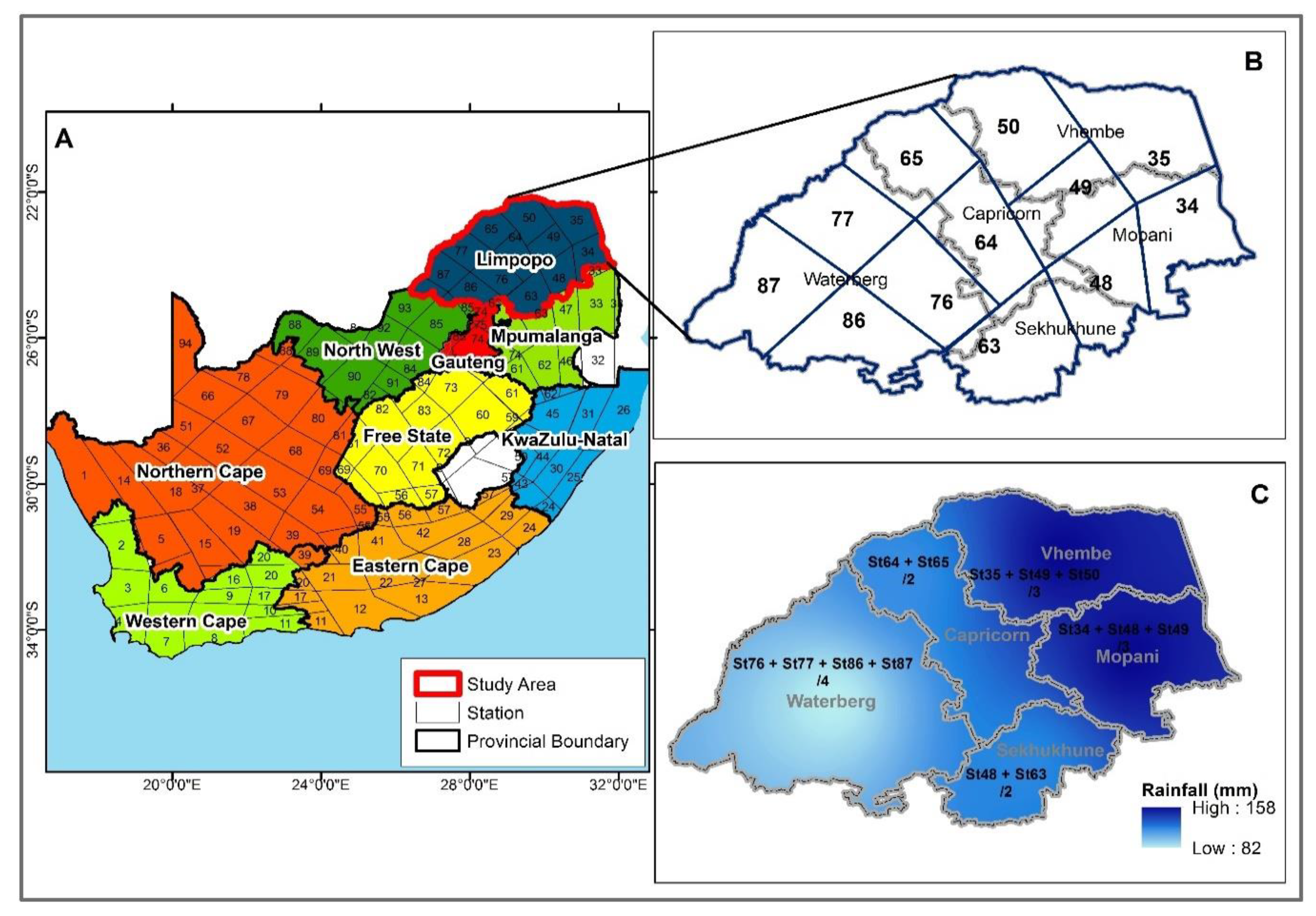
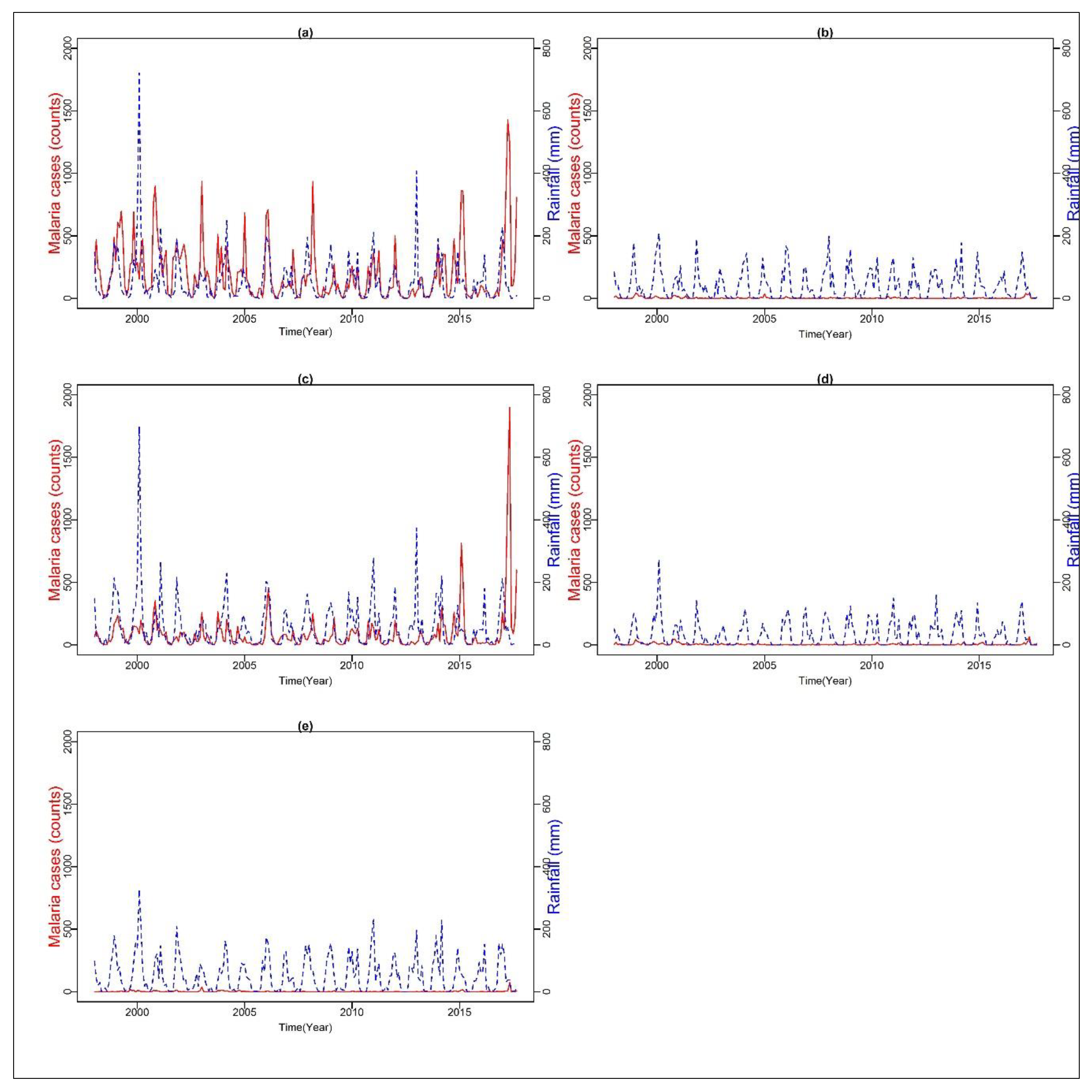
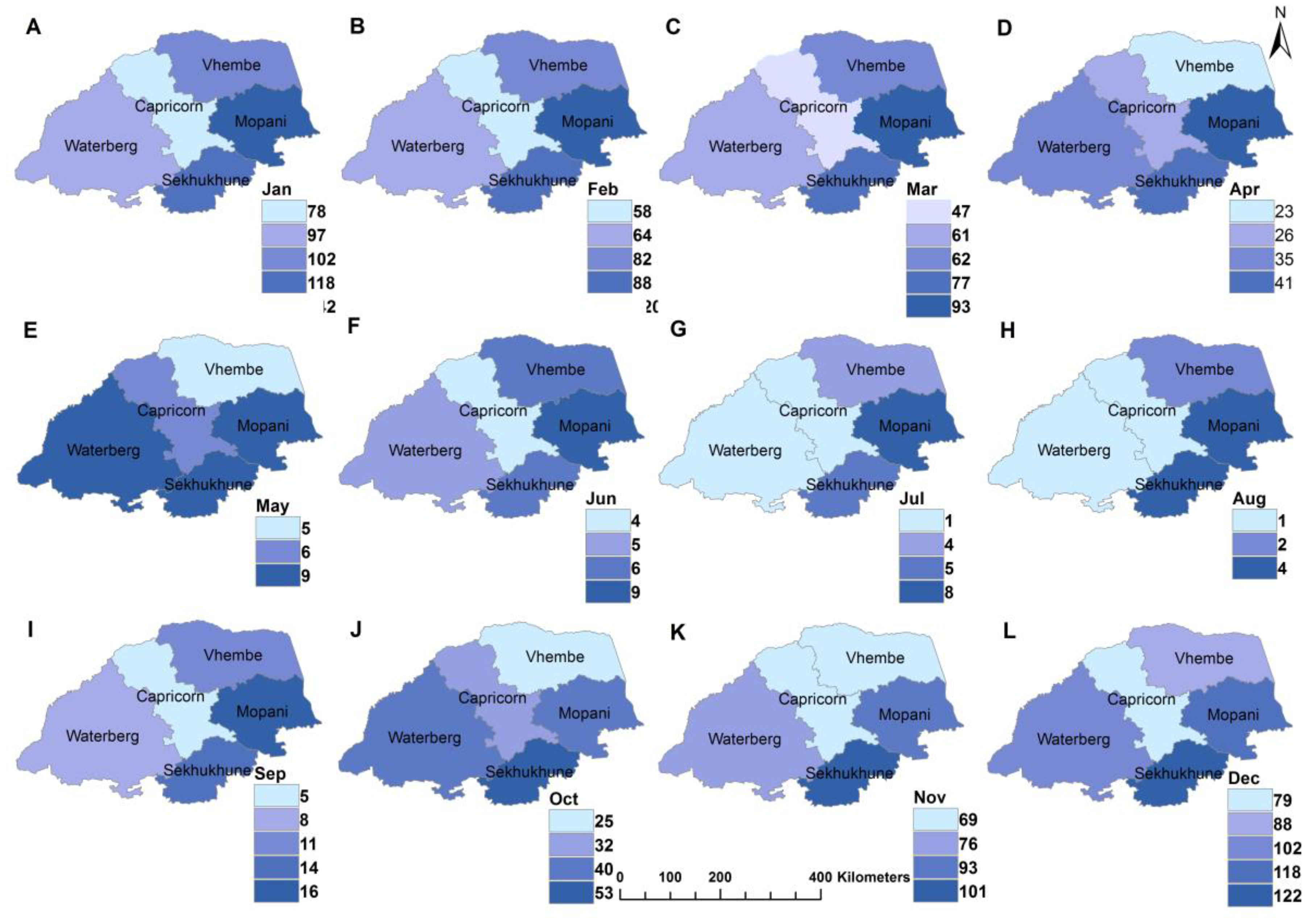
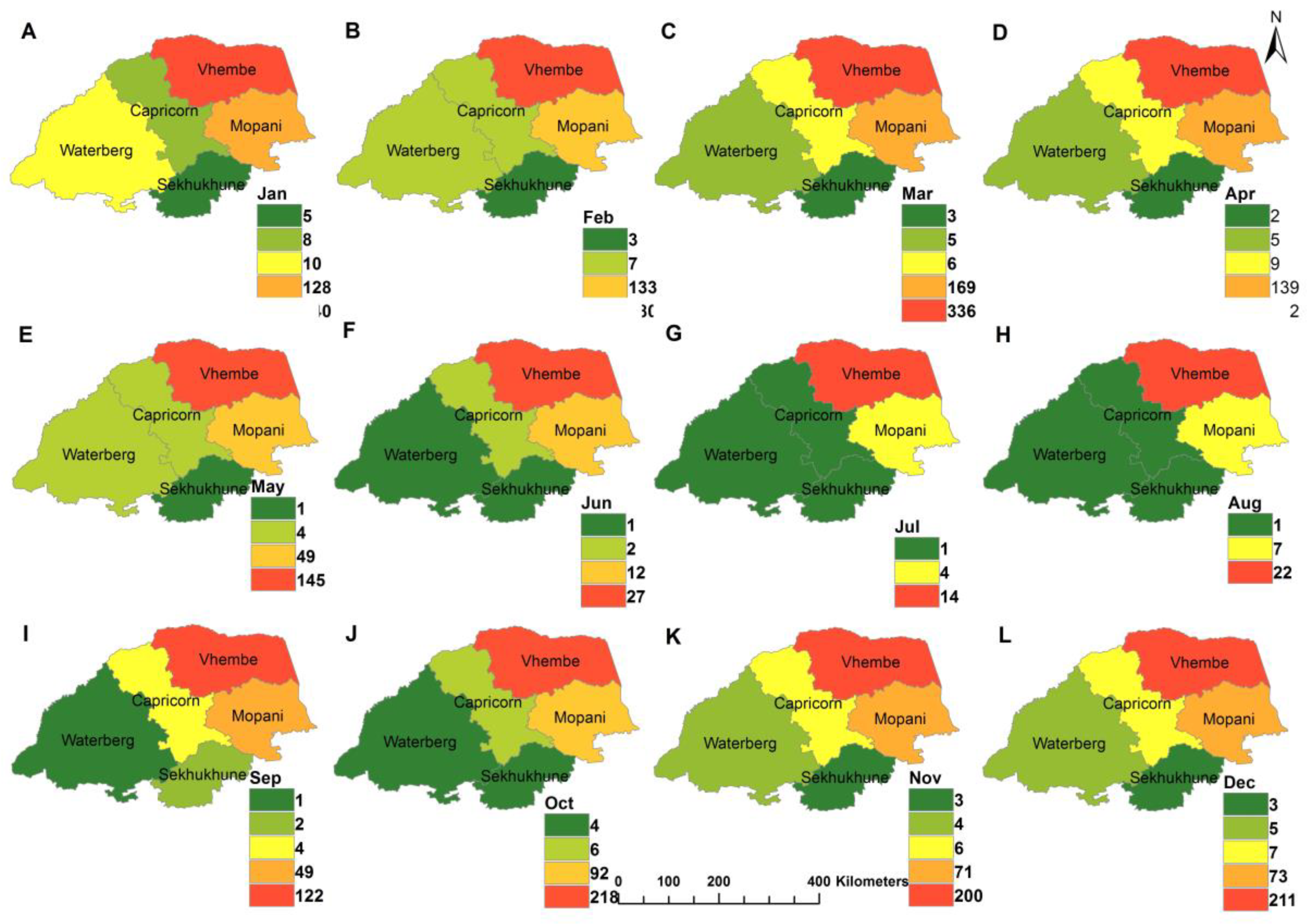

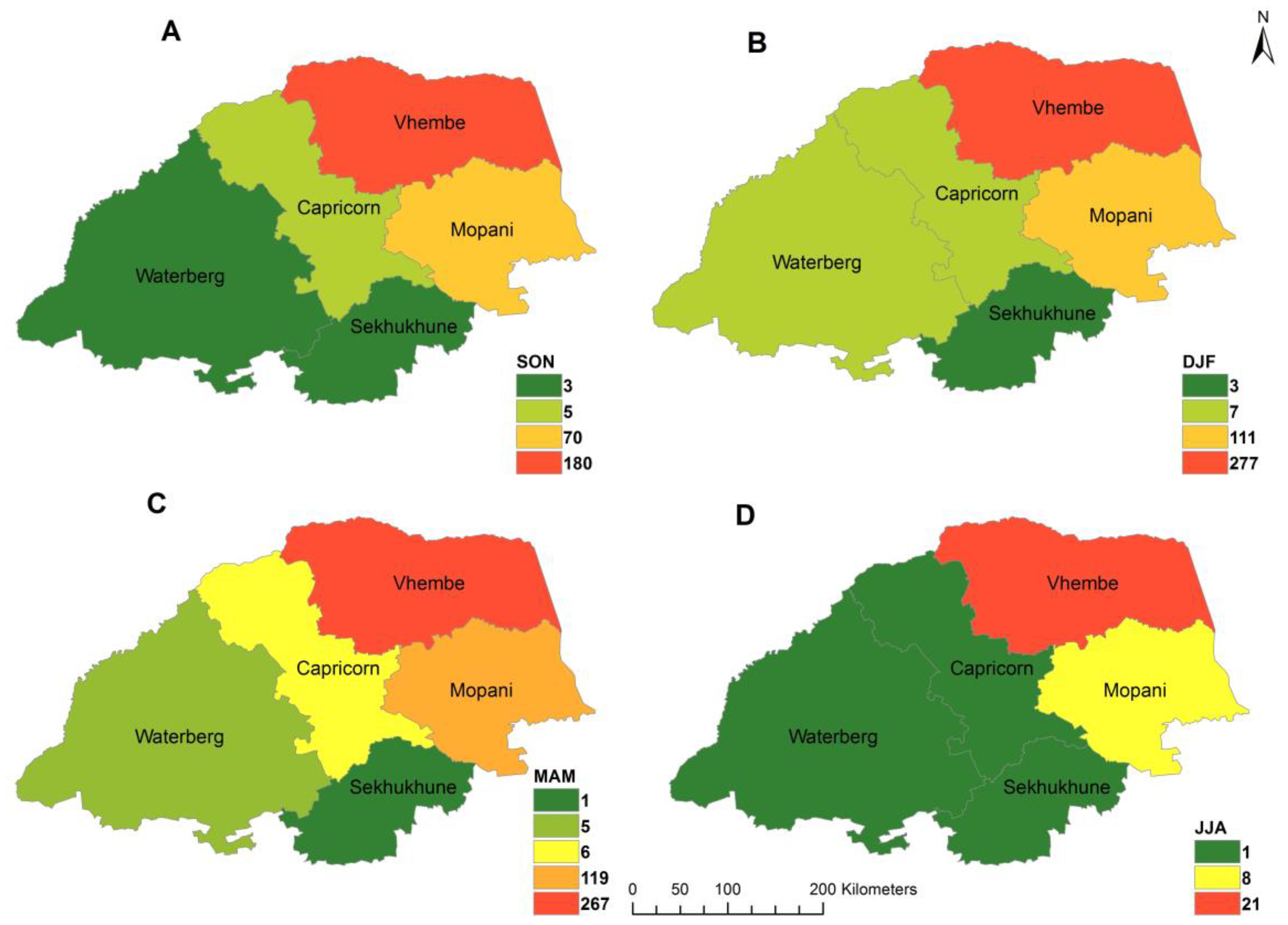
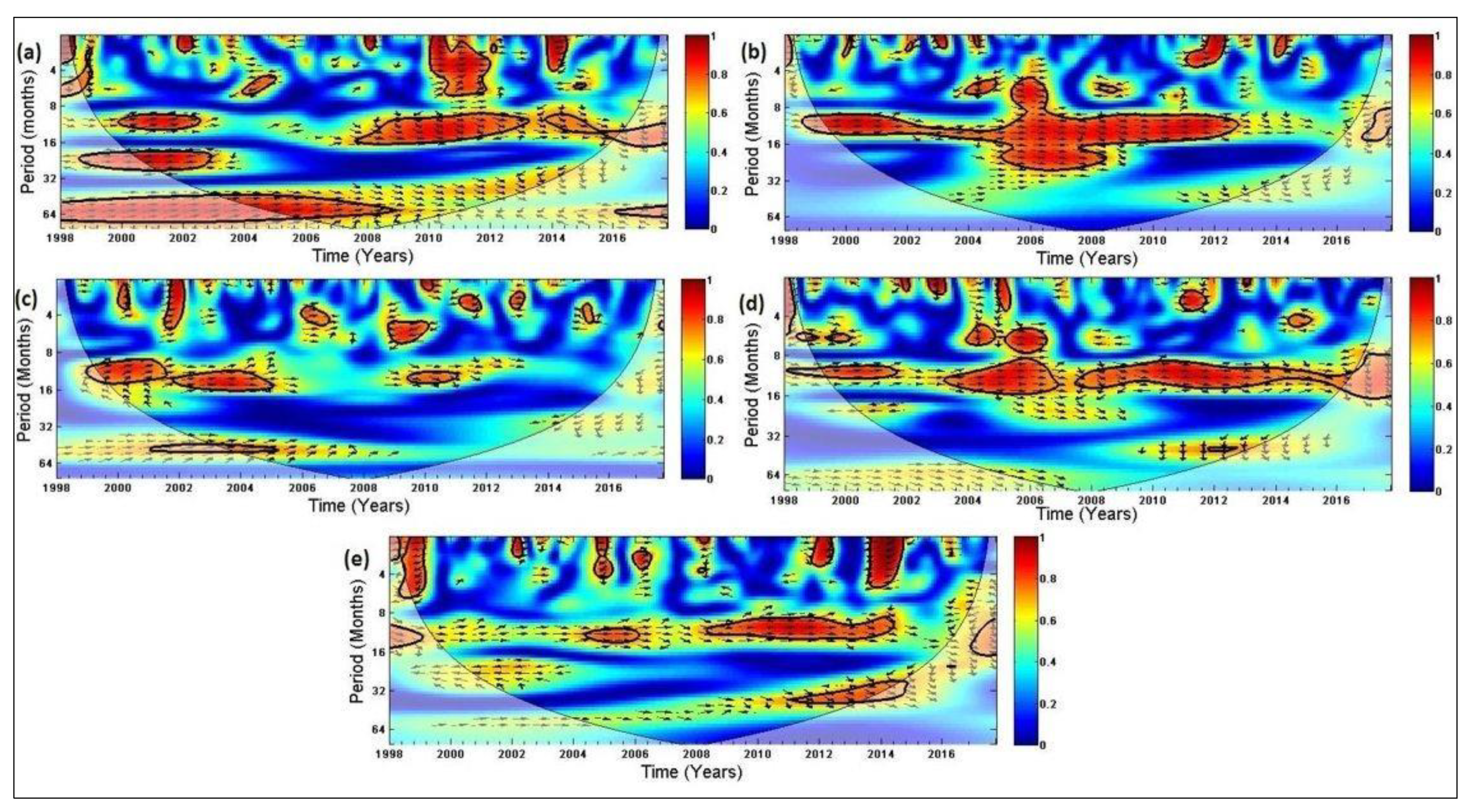
| Year | Malaria Cases | Local(%) | Imported(%) | Female | Male | Death |
|---|---|---|---|---|---|---|
| 1998 | 4082 | 2961(72.5) | 1121(27.5) | 1834 | 2248 | 59 |
| 1999 | 9093 | 6154(67.7) | 2939(32.3) | 4095 | 4998 | 112 |
| 2000 | 8553 | 5658(66.2) | 2895(33.8) | 4020 | 4533 | 71 |
| 2001 | 6215 | 4049(65.1) | 2166(34.9) | 2838 | 3377 | 50 |
| 2002 | 4372 | 2982(68.2) | 1390(31.8) | 1850 | 2522 | 40 |
| 2003 | 6094 | 4387(72.0) | 1707(28.0) | 2831 | 3263 | 87 |
| 2004 | 4650 | 2875(61.8) | 1775(38.2) | 2026 | 2624 | 54 |
| 2005 | 3003 | 1673(55.7) | 1330(44.3) | 1307 | 1696 | 26 |
| 2006 | 5867 | 3734(63.6) | 2133(36.4) | 2537 | 3330 | 51 |
| 2007 | 2885 | 2114(73.3) | 771(26.7) | 1188 | 1697 | 34 |
| 2008 | 4397 | 3007(68.4) | 1390(31.6) | 1808 | 2589 | 29 |
| 2009 | 3153 | 1863(59.1) | 1290(40.9) | 1318 | 1835 | 35 |
| 2010 | 4300 | 2506(58.3) | 1794(41.7) | 1756 | 2544 | 43 |
| 2011 | 3492 | 2023(57.9) | 1469(42.1) | 1296 | 2196 | 32 |
| 2012 | 2016 | 1435(71.2) | 581(28.8) | 748 | 1268 | 22 |
| 2013 | 2408 | 1563(64.9) | 845(35.1) | 976 | 1432 | 27 |
| 2014 | 5727 | 4115(71.9) | 1612(28.1) | 2358 | 3369 | 101 |
| 2015 | 5357 | 4543(84.8) | 814(15.2) | 2302 | 3055 | 83 |
| 2016 | 1377 | 917(66.6) | 460(33.4) | 549 | 828 | 17 |
| 2017 | 30,558 | 28,516(93.3) | 2042(6.7) | 12,975 | 17,583 | 301 |
| TOTAL | 117,599 | 87,075(74) | 30,524(26) | 50,612(43) | 66,987(57) | 1274 |
| District | Malaria | Rainfall | ||
|---|---|---|---|---|
| p-Value | Trend | p-Value | Trend | |
| Vhembe | 0.0025 | −0.34 | 0.19 | −0.027 |
| Waterberg | 0.021 | 0 | 0.72 | 0 |
| Mopani | 0.60 | −0.019 | 0.28 | −0.025 |
| Capricorn | 0.00043 | −0.0055 | 0.91 | 0 |
| Sekhukhune | 0.70 | 0 | 0.71 | −0.0049 |
© 2019 by the authors. Licensee MDPI, Basel, Switzerland. This article is an open access article distributed under the terms and conditions of the Creative Commons Attribution (CC BY) license (http://creativecommons.org/licenses/by/4.0/).
Share and Cite
Adeola, A.; Ncongwane, K.; Abiodun, G.; Makgoale, T.; Rautenbach, H.; Botai, J.; Adisa, O.; Botai, C. Rainfall Trends and Malaria Occurrences in Limpopo Province, South Africa. Int. J. Environ. Res. Public Health 2019, 16, 5156. https://doi.org/10.3390/ijerph16245156
Adeola A, Ncongwane K, Abiodun G, Makgoale T, Rautenbach H, Botai J, Adisa O, Botai C. Rainfall Trends and Malaria Occurrences in Limpopo Province, South Africa. International Journal of Environmental Research and Public Health. 2019; 16(24):5156. https://doi.org/10.3390/ijerph16245156
Chicago/Turabian StyleAdeola, Abiodun, Katlego Ncongwane, Gbenga Abiodun, Thabo Makgoale, Hannes Rautenbach, Joel Botai, Omolola Adisa, and Christina Botai. 2019. "Rainfall Trends and Malaria Occurrences in Limpopo Province, South Africa" International Journal of Environmental Research and Public Health 16, no. 24: 5156. https://doi.org/10.3390/ijerph16245156
APA StyleAdeola, A., Ncongwane, K., Abiodun, G., Makgoale, T., Rautenbach, H., Botai, J., Adisa, O., & Botai, C. (2019). Rainfall Trends and Malaria Occurrences in Limpopo Province, South Africa. International Journal of Environmental Research and Public Health, 16(24), 5156. https://doi.org/10.3390/ijerph16245156






